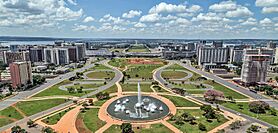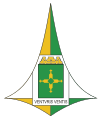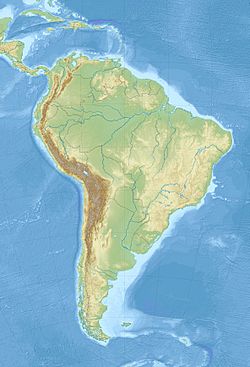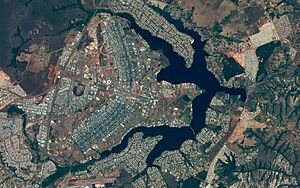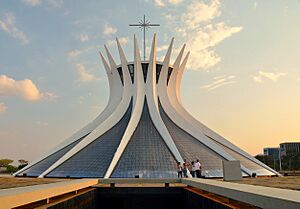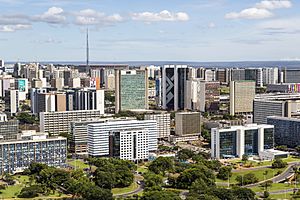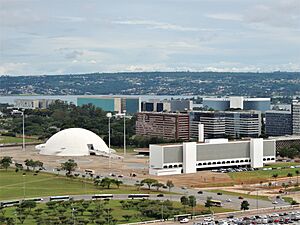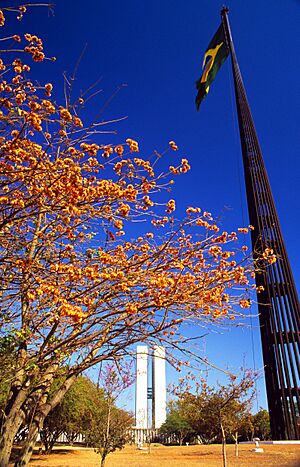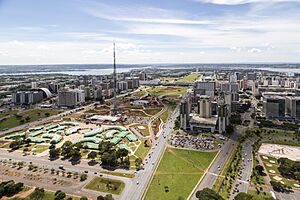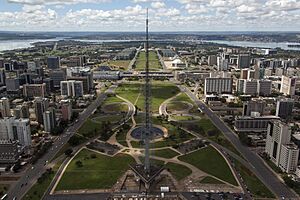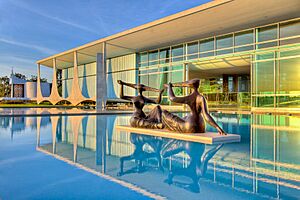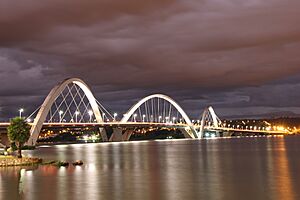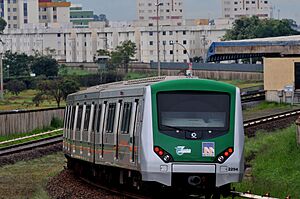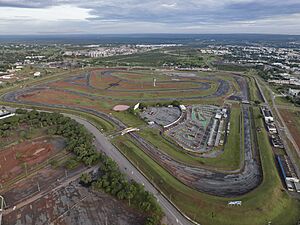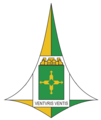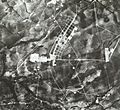Brasília facts for kids
Quick facts for kids
Brasília
|
|||
|---|---|---|---|
|
Federal capital
|
|||
|
Monumental Axis seen from the TV Tower
Alvorada Palace
Juscelino Kubitschek bridge
National Congress of Brazil
Panoramic view of the Pilot Plan of Brasilia
|
|||
|
|||
| Nicknames:
Capital Federal, BSB, Capital da Esperança
|
|||
| Motto(s):
"Venturis ventis"(Latin)
"To the coming winds" |
|||
| Country | |||
| Region | Central-West | ||
| District | Federal District | ||
| Founded | 21 April 1960 | ||
| Area | |||
| • Federal capital | 5,802 km2 (2,240.164 sq mi) | ||
| Elevation | 1,172 m (3,845 ft) | ||
| Population
(2022)
|
|||
| • Density | 489.06/km2 (1,266.7/sq mi) | ||
| • Urban | 2,817,381 (3rd) | ||
| • Metro | 3,548,438 (4th) | ||
| urban area is population of the Federal District; metro area includes 12 neighboring municipalities in Goiás | |||
| Demonym(s) | Brasiliense | ||
| GDP | |||
| • Year | 2015 estimate | ||
| • Total | $65.338 billion (8th) | ||
| • Per capita | $21,779 (1st) | ||
| HDI | |||
| • Year | 2014 | ||
| Time zone | UTC−03:00 (BRT) | ||
| Postal code |
70000-000
|
||
| Area code(s) | +55 61 | ||
| HDI (2010) | 0.824 – very high | ||
| Website | |||
| Official name: Brasilia | |||
| Type: | Cultural | ||
| Criteria: | i, iv | ||
| Designated: | 1987 (11th session) | ||
| Reference #: | 445 | ||
| Region: | Latin America and the Caribbean | ||
Brasília is the capital city of Brazil. It is where the main government offices are located. The city is in the Brazilian highlands in the country's central-west area.
Brasília was started by President Juscelino Kubitschek on April 21, 1960. It was built to replace Rio de Janeiro as the capital. Today, Brasília is Brazil's third-largest city by population. It also has the highest GDP per capita (meaning the average income per person) among major cities in Latin America.
This city is special because it was completely planned before it was built. Architects Lúcio Costa, Oscar Niemeyer, and Joaquim Cardozo designed it in 1956. Their goal was to move the capital to a more central spot in Brazil. The city's design looks like an airplane from above!
Brasília is famous for its modern, white buildings designed by Oscar Niemeyer. All three parts of Brazil's government are here: the President (executive), the Congress (legislative), and the Supreme Court (judiciary). Many foreign embassies are also in Brasília.
The city's international airport connects it to other big Brazilian cities and some international places. It's the third busiest airport in Brazil. Brasília also hosted games for the 2014 FIFA World Cup and the 2016 Summer Olympics.
The "airplane" shape of the city has a "fuselage" called the Monumental Axis. This is a wide area with big avenues and a park. The "cockpit" is the Praça dos Três Poderes (Three Powers Plaza). This plaza is named for the three government branches located there. Brasília is unique because it's an administrative region, not a regular city.
The name "Brasília" is often used to mean the whole Federal District. This district is split into 35 smaller areas. One of these, Plano Piloto, includes the original planned city and its government buildings.
Contents
What Does Brasília Mean?
The name Brasília comes from the Latin word for Brazil. It was first suggested as a name for the capital in 1821 by José Bonifácio de Andrada e Silva.
How Brasília Was Built
Why a New Capital?
Brazil's first capital was Salvador. Then, in 1763, Rio de Janeiro became the capital and stayed that way until 1960. Most of Brazil's people and resources were near the coast. Moving the capital to Brasília, in the center of the country, helped spread development more evenly.
The idea to move the capital started way back in 1827. José Bonifácio, an advisor to Emperor Pedro I, suggested a new city called Brasília. He wanted to move the capital away from the crowded coast. However, his plan didn't happen at that time.
There's a legend that an Italian saint, Don Bosco, had a dream in 1883. He described a future city that matched Brasília's location. Today, you can find many things named after Don Bosco in Brasília, including a church.
The City's Design Plan
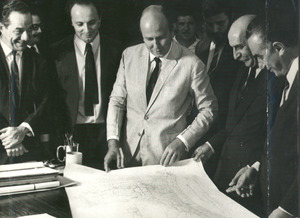
Juscelino Kubitschek became President of Brazil in 1956. He promised to build the new capital. In 1957, a group of international judges chose Lúcio Costa's plan for Brasília. Costa was a student of a famous architect named Le Corbusier.
Costa's plan was chosen because it had the right features for a growing capital city. Even though some things changed later, his main ideas for the city's layout stayed.
The plan used a cross shape, like an airplane or a bird, to show that this was a new, important place. It had two main parts:
- The Monumental Axis (east to west): This part was for government buildings. It has wide avenues and big, simple buildings. Here you find ministries, the national congress, and the presidential palace.
- The Residential Axis (north to south): This part was for homes and daily life. It included areas for shops, schools, parks, and churches. It had special areas called "superblocks" with apartment buildings. The idea was to create small, self-sufficient neighborhoods.
The design also focused on making it easy for cars to move around. This was a very modern idea at the time. Later, as more people moved to Brasília, traffic lights and a metro system were added to help with transportation.
Building the City
Juscelino Kubitschek ordered Brasília to be built. It was part of his plan for "fifty years of prosperity in five." Lúcio Costa was the main city planner. Oscar Niemeyer designed most of the public buildings. Joaquim Cardozo was the engineer for the structures, and Roberto Burle Marx designed the landscapes.
Brasília was built very quickly, in just 41 months! Construction started in 1956 and the city was officially opened on April 21, 1960.
Brasília's Location and Weather
The city is high up, over 1,000 meters (about 3,280 feet) on the Brazilian Highlands. A large artificial lake, Paranoá Lake, was built to provide water and keep the air humid. It's a popular spot for water sports like wakeboarding and windsurfing. You can even dive to see an old submerged village called Vila Amaury, where the first construction workers lived.
Brasília has a tropical savanna climate. This means it has two main seasons:
- The rainy season from October to April.
- The dry season from May to September.
The average temperature is about 21.4°C (70.5°F). During the dry season, the air can get very dry, sometimes below 30% humidity.
People of Brasília
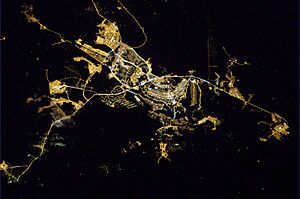
Brasília is home to many different people. According to the 2022 census, the population of Brasília and its surrounding area is about 2.8 million.
- About 48.7% of people are of mixed heritage.
- About 40% are White.
- About 10.7% are Black.
- Smaller groups include Asian and Indigenous people.
Brasília has grown very fast. In 1960, there were about 140,000 people. By 2010, the Federal District had over 2.5 million people. Many people moved to Brasília from other parts of Brazil to find jobs.
The city also has many foreign residents, especially people who work at embassies. Brasília has a high Human Development Index (HDI), which means people generally have a good quality of life, with high literacy rates.
Religions
Most people in Brasília are Christian, with Catholicism being the largest group.
| Religion | Percentage | Number |
|---|---|---|
| Catholic | 56.62% | 1,455,134 |
| Protestant | 26.88% | 690,982 |
| No religion | 9.20% | 236,528 |
| Other | 3.72% | 95,605 |
| Spiritist | 3.50% | 89,836 |
| Jewish | 0.04% | 1,103 |
| Muslim | 0.04% | 972 |
| Total | 100.00% | 2,570,160 |
Source: IBGE 2010.
Brasília's Economy
Brasília's economy is mainly based on government services. This includes things like communications, banking, and legal services. Construction is also a big part of the economy.
Other important industries are food processing, furniture making, and computer software. The city's government tries to attract non-polluting industries. This helps protect the environment and the city's unique design.
In 2018, Brasília had the third-highest GDP (total value of goods and services produced) among Brazilian cities. This shows it's an important economic center.
Main Industries and Products
Some of the industries in Brasília include:
- Construction companies.
- Food processing companies.
- Furniture making.
- Recycling plants.
- Pharmaceutical companies.
- Graphic design and printing.
The area around Brasília also produces farm goods like coffee, fruits (guavas, strawberries, oranges, lemons, papayas, mangoes), and soybeans. It also has many cows and exports wood products.
The Federal District, where Brasília is located, has a very high GDP per person. This makes it one of the richest areas in Brazil.
Culture and Fun in Brasília
Brasília is a lively city with many cultural events. It hosts music performances and movie festivals. With many embassies, it's a very international city. There are also lots of restaurants and hotels, making it a popular place for business and tourism.
Throughout the year, Brasília has traditional parties. In June, there are "festas juninas" celebrating Catholic saints. On September 7th, the Independence Day parade takes place. Christmas and New Year's Eve are also celebrated with big events.
The city is like an open-air art gallery. You can see works by famous artists like Bruno Giorgi and Athos Bulcão integrated into the buildings. The food scene is also very diverse, with many great restaurants.
Brasília is known as the birthplace of Brazilian rock music. Famous bands like Legião Urbana and Capital Inicial started here. The city also hosts the Rock Basement Festival for new bands.
Since 1965, the Brasília Festival of Brazilian Cinema has been a major event. It focuses only on Brazilian movies. The International Dance Seminar in Brasília also brings top dancers and teachers to the city.
Brasília has even appeared in books and comics. The book The World In Grey: Dom Bosco's Prophecy is based on a legend about the city. The comic series American Flagg! shows Brasília as a fun, cultural world capital.
Buildings and City Design
At the Square of Three Powers, architect Oscar Niemeyer and engineer Joaquim Cardozo designed amazing modern buildings. The National Congress building is a key example. It has a big lawn and reflecting pool in front.
Roberto Burle Marx designed beautiful gardens for some of the main buildings. The residential areas have buildings inspired by modern European designs.
Brasília was planned to offer a high quality of life. People live in green areas with sports and leisure facilities. The city is known for its food and efficient transportation. However, some people call it a "fantasy island." This is because it contrasts sharply with the poorer areas around it.
Famous Buildings
The Cathedral of Brasília is a stunning building. It has a unique concrete structure that looks like hands reaching up to the sky. It was finished in 1970.
The Eixo Monumental (Monumental Axis) is a large open area in downtown Brasília. It has wide avenues and many government buildings. On weekends, it's closed to cars so people can walk, bike, and have picnics.
The Praça dos Três Poderes (Square of the Three Powers) is a famous plaza. It's where the three main parts of the government meet:
- The President's office (Palácio do Planalto).
- The National Congress.
- The Supreme Federal Court.
It was designed to show these three powers working together.
The Palácio da Alvorada is the official home of the president of Brazil. It was designed by Oscar Niemeyer and opened in 1958. It sits on a peninsula by Lake Paranoá. The building looks like a glass box resting on thin columns. It has many rooms, including a library, swimming pool, and meeting rooms.
The Palácio do Planalto is the official workplace of the president of Brazil. It's also located at the Praça dos Três Poderes. This building is where the President and top advisors work. It was also designed by Oscar Niemeyer, with simple, modern lines.
Learning in Brasília
Brasília has many schools and universities. There are six international schools, including the American School of Brasília and the British School of Brasília.
The main universities are:
- University of Brasília (public).
- Catholic University of Brasília.
- And several other university centers and private colleges.
Getting Around Brasília
Many people in Brasília use public transportation. The average commute time is about 96 minutes. Buses and the metro are important for getting around.
Airport
The Brasília–Presidente Juscelino Kubitschek International Airport serves the city. It's the third busiest airport in Brazil. Its location makes it a key hub for flights across the country.
The airport has many shops, a food court, and movie theaters. It's about 11 km (7 miles) from the city center. You can take taxis or buses from the airport. The airport has been expanded to handle more passengers, especially after Brazil hosted big events.
Roads and Bridges
Brasília has a good network of taxi services. The Juscelino Kubitschek bridge, also called the 'President JK Bridge', is a famous landmark. It crosses Lake Paranoá. This bridge was designed by architect Alexandre Chan and engineer Mário Vila Verde. It has three tall, unique steel arches. The bridge is 1,200 meters (0.75 miles) long and has walkways for pedestrians and cyclists.
The main bus station is the Central Bus Station. It's located in the middle of the city. This station is for city buses that run within Brasília and connect to nearby satellite cities. There's also an interstate bus station for longer trips.
Metro System
Brasília has a metro system called the Federal District Metro. It has 24 stations on two lines, the Orange and Green lines. The metro covers about 43 km (27 miles).
The metro mainly serves the satellite cities around Brasília, like Samambaia and Taguatinga. These areas have more people than the original planned city. Most residents in these satellite cities rely on public transportation.
Sports in Brasília
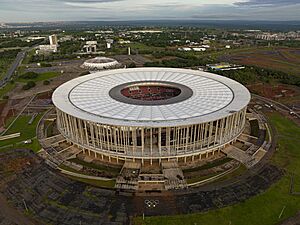
Brasília has several sports stadiums. The main ones are the Estádio Nacional Mané Garrincha, the Serejão Stadium, and the Bezerrão Stadium.
There are a few professional football clubs in Brasília, but they are not currently in the top national leagues. Football clubs from Rio de Janeiro and São Paulo are more popular here.
Brasília was one of the host cities for the 2014 FIFA World Cup and the 2013 FIFA Confederations Cup. It also hosted football matches during the 2016 Summer Olympics.
The city is also a great place for air sports like hang gliding and paragliding. The dry weather creates strong winds that are perfect for these activities. Brasília hosted the 14th Hang Gliding World Championship in 2003.
Brasília is home to the Autódromo Internacional Nelson Piquet racetrack. It has hosted international car races in the past. The city also has a successful basketball team, Uniceub BRB, which plays at the Nilson Nelson Gymnasium.
Images for kids
-
Panoramic view of the Pilot Plan of Brasilia
-
The foundation stone of Brasilia, Centennial Hill, erected in 1922 to celebrate the 100th anniversary of Brazil's independence
-
Urban planner Lúcio Costa was the winner of the competition for the construction project of Brasília and played a key role in the city's landmarking.
-
Brasilia at night from ISS
-
Estádio Nacional Mané Garrincha and Nilson Nelson Gymnasium (background)
See also
 In Spanish: Brasilia para niños
In Spanish: Brasilia para niños


